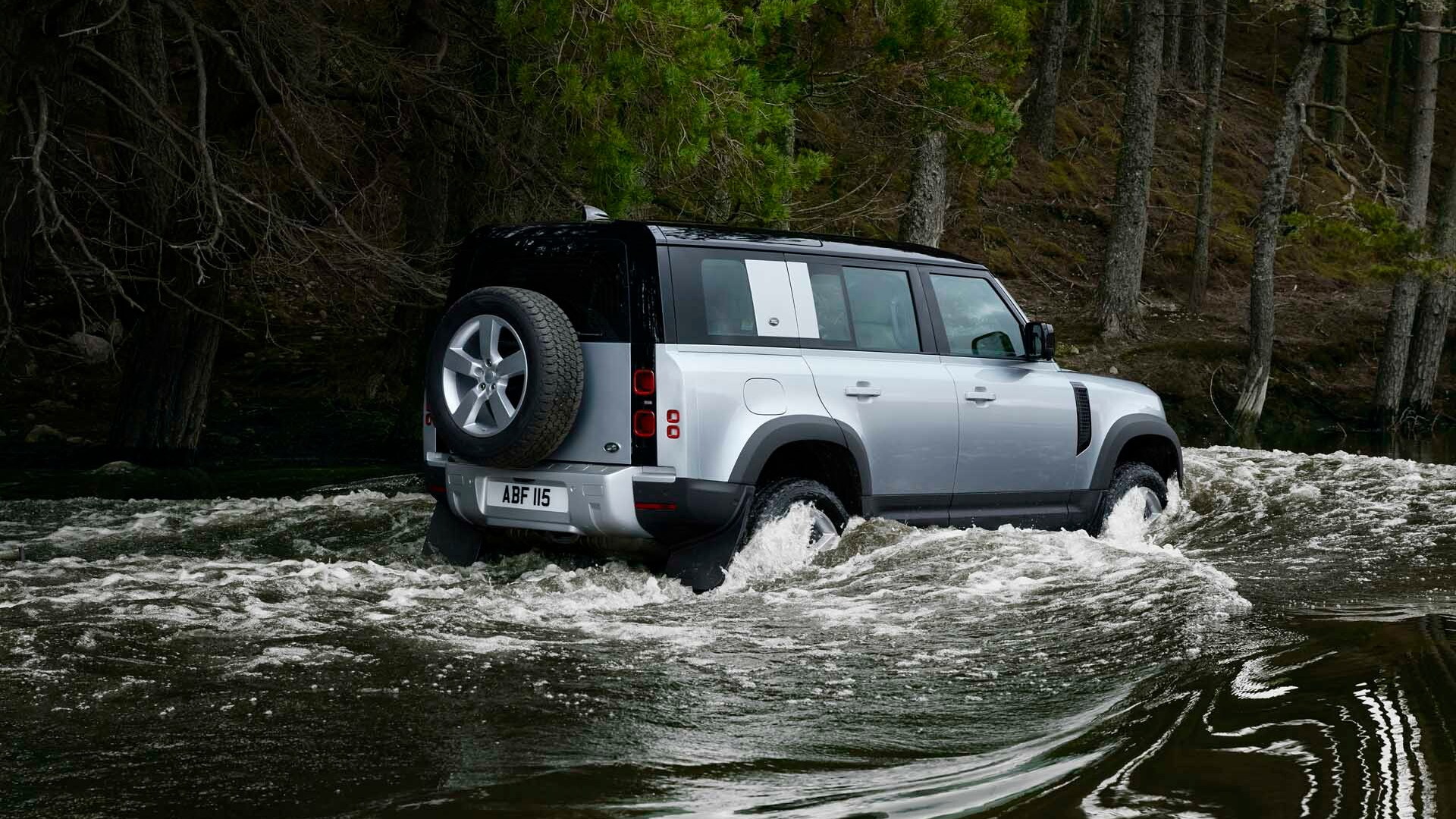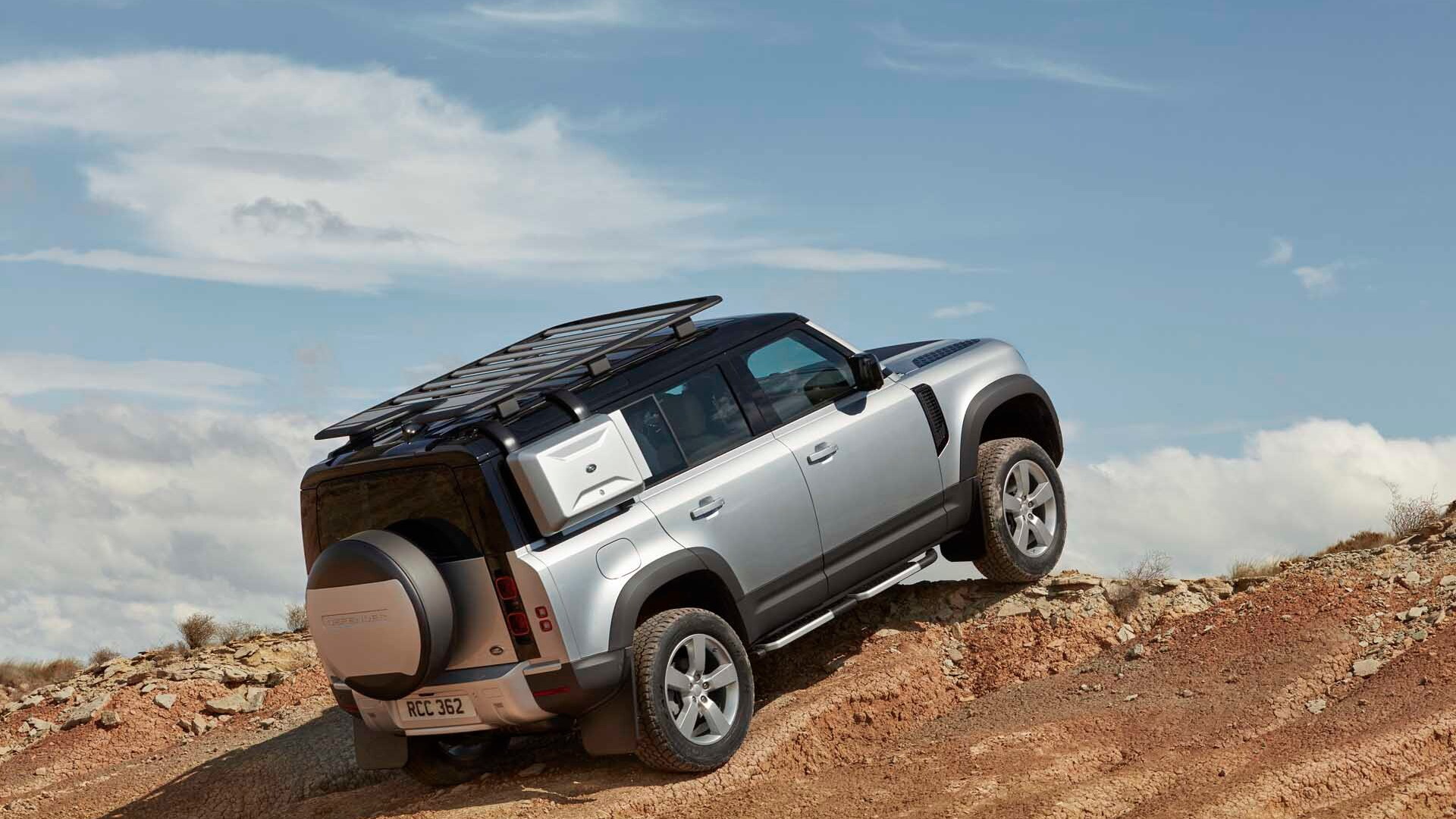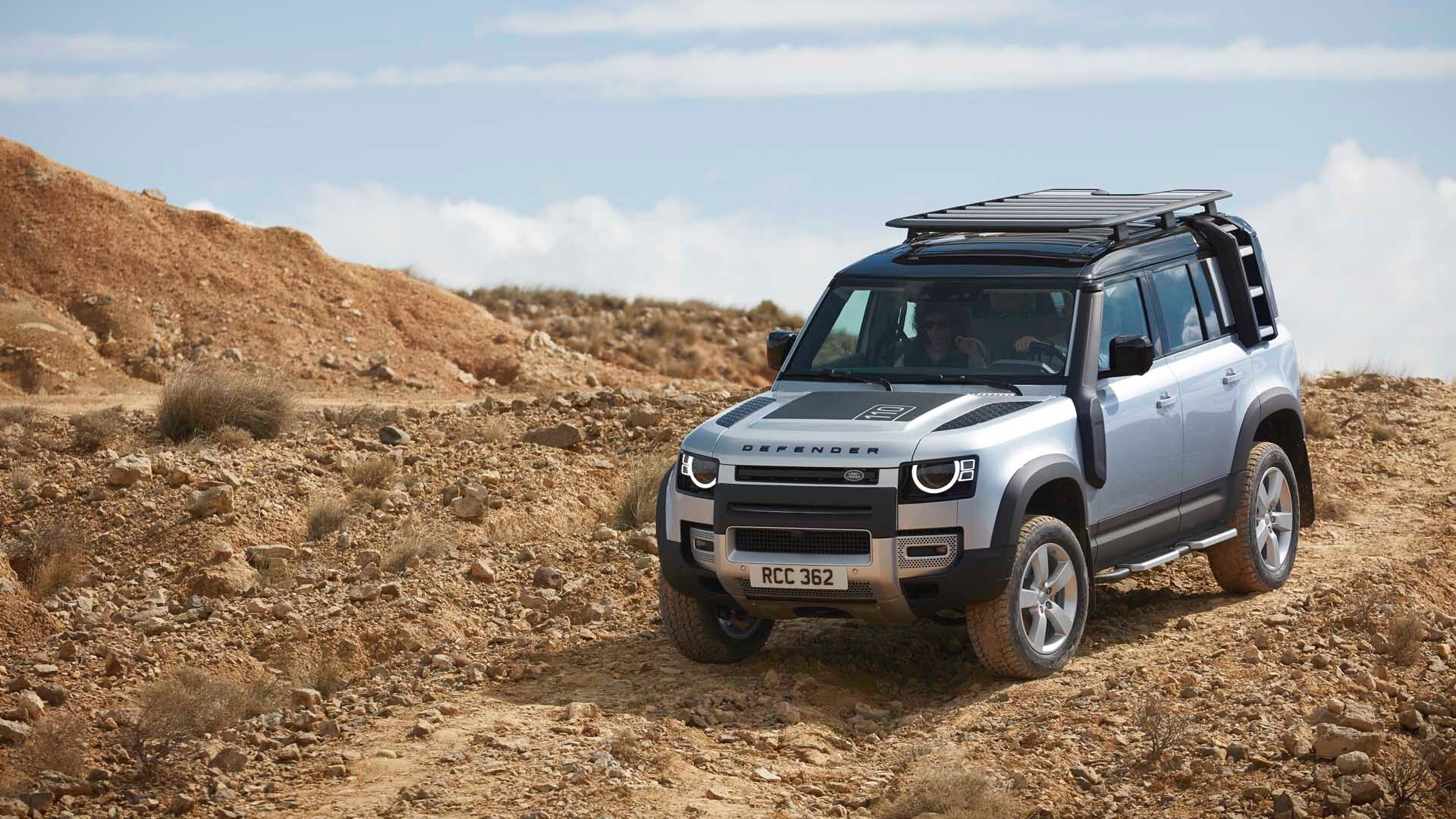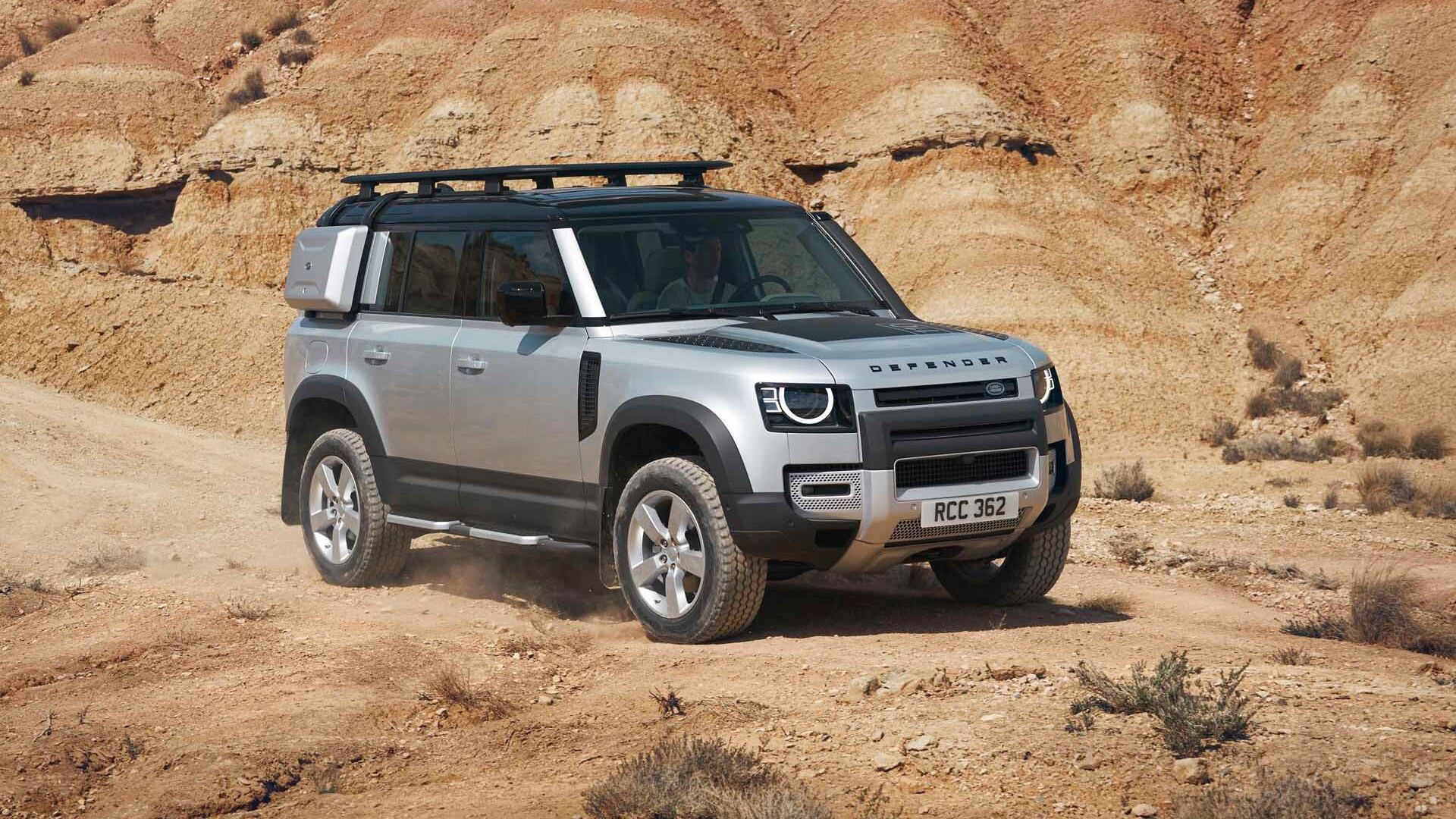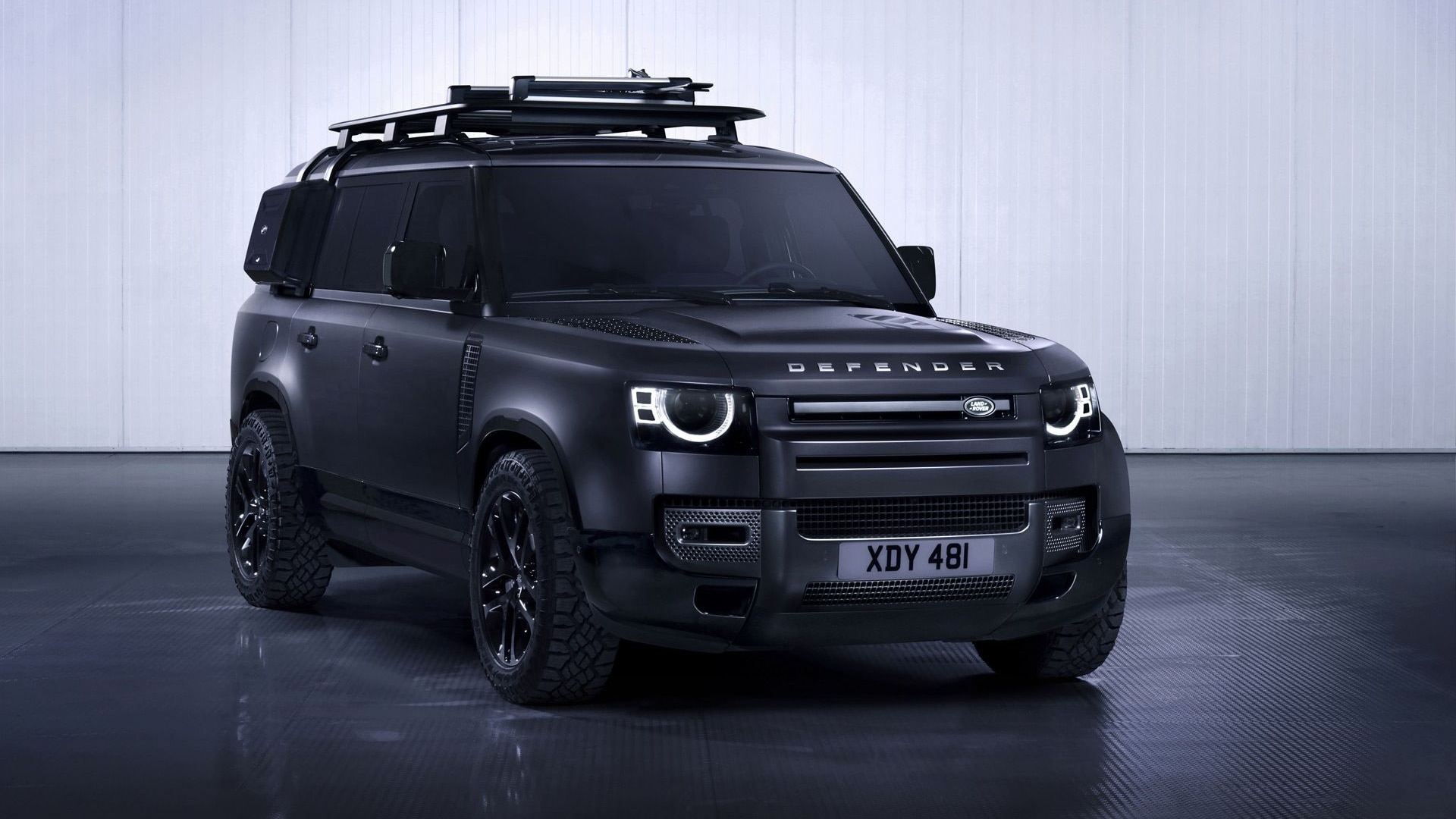It’s a dry, 60-degree October day in Chicago and it’s now or never no matter how ill-advised my mission may be. A 2020 Land Rover Defender 110 First Edition dropped in my lap two days ago and I can’t review this British four-wheeler without taking it four-wheeling. Busy friends and a coworker who understandably doesn’t want to work the weekend leave me to brave the rigors of The Cliffs Insane Terrain Off-Road Park in Marseilles, Illinois, on my own. No spotter? No problem. Nobody to help me push it out if I get stuck? I’ll chance it. The reborn Defender should be able to handle it.
The gods of mud and dirt smile upon me at check-in as a late-model Jeep Wrangler Rubicon four-door pulls up next to me, having just braved the trail. The four-door Wrangler is the Defender’s natural enemy and this gives me a great opportunity to compare them side-by-side.

2020 Land Rover Defender 110
The length and wheelbase are very similar, but the Defender is notably wider and taller by 4.8 and 3.8 inches, respectively. The Defender sits 2.2 inches lower off the ground at rest, but the Defender’s air suspension raises it 2.9 inches in the off-road modes, making it 0.7 inch taller. The Wrangler has a shorter front overhang, but the Defender is shorter in the back. The Defender’s extra width and height make it look like the Wrangler’s big, British brother.
Both also look the part of off-roaders. The Jeep’s iconic boxy look has been around for generations and the Defender’st all, upright stance sports knobby tires, rear-mounted spare, and blacked out hood and roof. This tester also has the Explorer Pack, which adds to the off-road feel with such features as an A-pillar-mounted snorkel, a hefty roof rack, mud flaps, and side-mounted storage box. People seem to like it both on the road and at the trail, even Jeep Wrangler drivers.

2020 Land Rover Defender 110

2020 Land Rover Defender 110

2020 Land Rover Defender 110
Insane terrain
Trail 1 at The Cliffs Insane Terrain is bumpy and rutty, with occasional hills and descents. I throw the Defender’s Terrain Response system into Grass/Gravel/Snow mode and set out for some fun. It sets the powertrain, steering, traction control, and center and rear differentials to work best on slick terrain. Its unique advantage, however, is its 11.5 inches of off-road ground clearance, enabled by the air suspension.
Proceeding at a deliberate pace, the larger bumps and ruts are no challenge for the Defender. I even seek them out because when you have a billy goat you should use it like a billy goat. Roughly a third of the way through the trail I come to an off-road terrain park that looks like a small racetrack with two 180-degree banked turns separated by two small but steeply angled hills. It’s a low-speed challenge for off-road trucks and SUVs or a small, higher-speed motocross course.
At first, the hills look like they might be too steeply pitched for the Defender’s 28-degree breakover angle. This is the longer 110 model, after all, not the shorter, two-door 90 model that will arrive for 2021. I give it a shot anyway and the Defender’s underbelly still has several inches of daylight between it and terra firma at the top of either hill. If I were driving with the Defender set at its on-road height, the breakover angle would drop to 22-degrees and still likely clear these hills. So would a Wrangler Rubicon with its 22.6 degrees of clearance.
Driving up and down these hills puts the approach and departure angles to the test as well. At the off-road height, the approach angle is 38 degrees, 5.4 degrees shy of the Wrangler Rubicon with its shorter nose. However, the Defender has a shorter tail as shown by its 40-degree departure angle versus 37 degrees for the Wrangler Rubicon. Either vehicle wouldn’t have a problem here.
The only challenge I face when driving around the steeply banked corners is getting out to take a picture and scrabbling to get back in.
Farther along, when I encounter the steep run down Superman Hill, I shift to neutral so I can switch to low-range gearing, then engage hill descent control and use what is essentially downhill cruise control. The vehicle hardly notices and I increase the speed to perhaps 10 mph to make this easy descent less mundane.

2020 Land Rover Defender 110

2020 Land Rover Defender 110

2020 Land Rover Defender 110
My drive continues along through more bumps and ruts, water too shallow to approach the Defender’s 35.4 inches of water fording capability (too bad, I wanted to see the Defender breathe through it’s snorkel as water washed over the hood), and rocky terrain that also proves no match for the ground clearance.
I avoid some deep mud holes and tight squeezes between trees where I could get stuck. Without a winch or a spotter, I don’t want to damage this vehicle. The off-road camera view can help as it shows the view dead ahead at bumper level and split views of each front tire. Still, if one of those tires is stuck in the muck, nobody’s here to help me pull it out.
However, I’m not passing up all of the challenges. The toughest test comes near the end of the trail. It’s a steep, layered rock face that gets even steeper at the top. I’m not sure the Defender will make it, but I re-engage low gearing, switch over to the Rock Crawl mode, and charge up hill.
The knobby Goodyear Wrangler A/T Adventure tires bite into the dirt and find traction on the rock face, the powertrain sets a slow but steady pace, and the Defender scrambles up the hill with surprising ease. At the top, I turn around and repeat the run in reverse. Again, progress is slow but steady. Hill descent control limits the speed, the tires don’t slip, and the hill is soon in my rearview mirror. All the while, I can watch the 4x4 info screen, which shows altitude, center lock on or off, side-to-side angle, forward/backward pitch, and the action of each damper.
A quick run over sharp rocks threatens a flat and I’m done here.
I’ve been through more technical terrain than this in other off-roaders, but this run shows me it’s as capable as the Wrangler Rubicon but in slightly different ways. Its width means it won’t sneak through some tight quarters the Jeep will handle, but its taller ground clearance gives it better breakover and departure angles. Both are great off-roaders.

2020 Land Rover Defender

2020 Land Rover Defender

2020 Land Rover Defender
Mannerly on-road
My drive home goes much like my drive to get there. The Explorer package roof rack causes unprecedented levels of wind noise and my infotainment system is a Wonderboom Bluetooth speaker because I haven’t been able to get the audio system to work at all. It’s a bold move for an automaker that has suffered much criticism for its infotainment systems to lend out a vehicle with infotainment that simply doesn’t work.
On the road, however, the Defender acts exactly like I hoped it would. The Defender may have Wrangler Rubicon levels of off-road capability, but it’s more car-like underneath and that makes it drive better. The Defender has electric-assist rack-and-pinion power steering instead of the Jeep’s recirculating ball, so it doesn’t suffer the same kind of on-center wander and is instead stable and direct, with weighting that starts out slightly heavy and gets heavier depending on the drive mode. An independent front suspension isolates bumps from side to side, and the unibody structure helps the Defender absorb bumps and ruts instead of bouncing over them. The Wrangler drives like a small, short-wheelbase truck with the busy ride to prove it. The Defender drives like a tall mid-size crossover, with the control that implies.
The turbocharged 3.0-liter inline-6 is also a joy. The engine employs not only a twin-scroll turbocharger, but also an electric supercharger enabled by a 48-volt electrical system. A belt-integrated starter motor aids acceleration and regenerative braking captures energy to improve fuel economy. Smooth and strong, the engine’s 395 horsepower and 406 pound-feet of torque provide willing pick up from a stop, but it does its best work above 3,000 rpm. The 0-60 mph run zips by in 5.8 seconds, and the inline-6 can tow up to 8,200 pounds. It’s stronger than any engine offered in the Wrangler or the upcoming Ford Bronco, and a supercharged V-8 is on the way as well. However, even with the regen capability, the inline-6 is not very efficient as I got just 13.7 mpg over 214 miles of driving.
Land Rover’s on-road modes are Comfort and Eco. While the throttle isn’t too lazy in either, I still program a de facto Sport mode into the configurable Terrain Response system by setting the powertrain to “responsive,” the traction control to “more wheel spin,” the differentials to “automatic,” and the steering to “medium” (heavy feels artificially heavy). My custom mode adds that extra bit of throttle response that I sometimes prefer.

2020 Land Rover Defender

2020 Land Rover Defender

2020 Land Rover Defender 110
Utility and space
Inside, the Defender is also exactly what I expected. The materials aren’t luxurious like in a Range Rover, but they’re right for the mission. Meant to withstand abuse, they’re rubberized, sturdy, utilitarian, and appropriate for the price. The seats are upholstered in cloth around the outside with leather inserts. Land Rover provides lots of storage trays, cubbies and pockets, and this model even has a refrigerated center console bin.
The Defender is much more comfortable than the Wrangler in the first two rows. Its extra width gives it more shoulder room for three across in back (and, optionally, in front, just like your grandpa’s 1970s Cadillac), and the tall roof creates 10-gallon hat head room. The second row also has good leg room.
A search of the cargo area reveals I’m driving a 5+2 model with a two-seat third row buried under the cargo floor. The third row is almost comically small, with seats that sit close to the floor and have highly restricted leg room. I see no reason to opt for it, especially with its $1,200 upcharge. I do like the switches in the rear that allow me to lower the Defender’s rear end to make it easier to load cargo. I’m not so happy with the side-hinged tailgate that blocks access from the curb, though it does make it possible for the Defender to carry its spare back there, which contributes to better ground clearance.

2020 Land Rover Defender 110

2020 Land Rover Defender

2020 Land Rover Defender
The 2020 Land Rover Defender 110 starts at $51,250, including destination. That model comes with a 296-hp 2.0-liter turbo-4, steel wheels, rubber flooring, a 10.1-inch touchscreen infotainment system, wireless smartphone charging, LED headlights, and the air suspension.
My First Edition tester costs $70,000 and comes with the inline-6, a Meridian sound system, a rear camera mirror, a panoramic sunroof, a black contrast roof, heated front seats, satellite radio, 20-inch alloy wheels, and unique trim inside and out. The Explorer pack adds another $4,800, and a smattering of other options bring the total to $79,190.
At its base levels, the 2020 Land Rover Defender’s price overlaps with higher-line versions of the Wrangler. Its air suspension stands out as a killer app for off-roaders, it’s more controlled on-road, and it’s roomier and better appointed inside, though I’d prefer one with a working infotainment system. If you get one, be sure to treat it like the billy goat it is.
Land Rover provided a 2020 Defender 110 without a working radio for the author to be alone with his thoughts while driving over or through anything that came his way.
